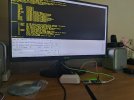Hello Phantom Pilots
I have had great success following instructions from @linuxkidd to install OpenWRT Luci to the RE700 Range Extender. This allowed me to access the web UI. It worked great and I learned a bunch of things.
Then following the same instructions, I wanted to install Luci to my Phantom 2 v+. Everything went well, and as expected I received the message that the install is blocked by Firewall *.
The instructions show to then remove this Firewall by typing the command: opkg remove firewall3
I typed: opkg remove firewall * So guess what happened next?
This removed all the operating files from the Wifi module. (i think) I received a long running list of "Removing......... lots of files and directories.
After that I was unable to issue any commands. I powered the drone off and on. And thereafter the wifi was not visible anymore. I guess the OpenWRT system will not load without any files.
Totally my mistake.
I then followed the instructions by @okstuv to repair the NAND with a FT232 board. This worked and thank you @okstuv , @gaucho , @andrew_by and @rmhome for all the information with this.
Unfortunately this did not fix my missing files, but it was worth a try.
Now I am not sure where the files are supposed to be. And I have come to the point of asking for help.
Will someone be able to give me information, if this is something to fix and if its possible at all?
I can not find the same problem and I have tried my best to get information. Of course this was all my mistake, so its not something that happened by itself.
Then I hope someone can assist.

Ernest
I have had great success following instructions from @linuxkidd to install OpenWRT Luci to the RE700 Range Extender. This allowed me to access the web UI. It worked great and I learned a bunch of things.
Then following the same instructions, I wanted to install Luci to my Phantom 2 v+. Everything went well, and as expected I received the message that the install is blocked by Firewall *.
The instructions show to then remove this Firewall by typing the command: opkg remove firewall3
I typed: opkg remove firewall * So guess what happened next?
This removed all the operating files from the Wifi module. (i think) I received a long running list of "Removing......... lots of files and directories.
After that I was unable to issue any commands. I powered the drone off and on. And thereafter the wifi was not visible anymore. I guess the OpenWRT system will not load without any files.
Totally my mistake.
I then followed the instructions by @okstuv to repair the NAND with a FT232 board. This worked and thank you @okstuv , @gaucho , @andrew_by and @rmhome for all the information with this.
Unfortunately this did not fix my missing files, but it was worth a try.
Now I am not sure where the files are supposed to be. And I have come to the point of asking for help.
Will someone be able to give me information, if this is something to fix and if its possible at all?
I can not find the same problem and I have tried my best to get information. Of course this was all my mistake, so its not something that happened by itself.
Then I hope someone can assist.
Ernest






